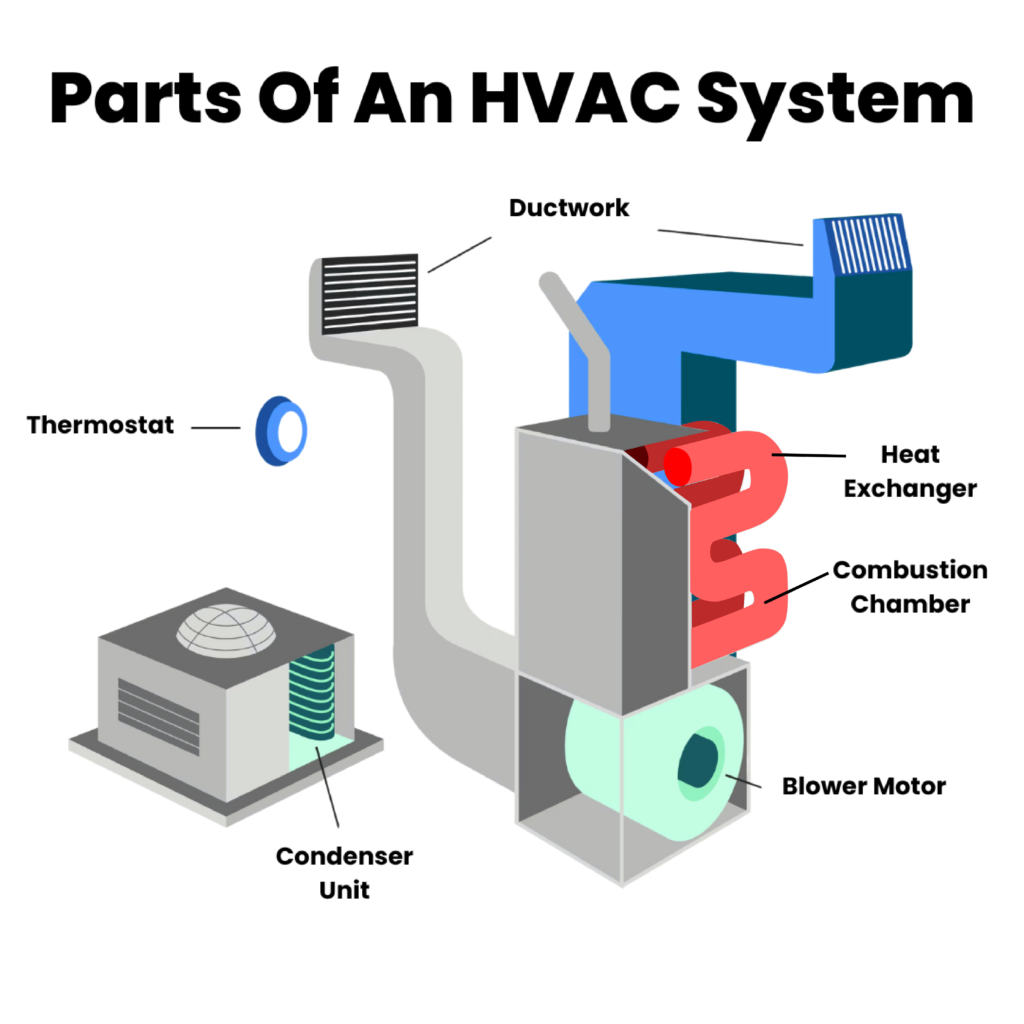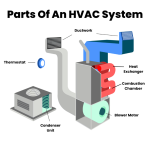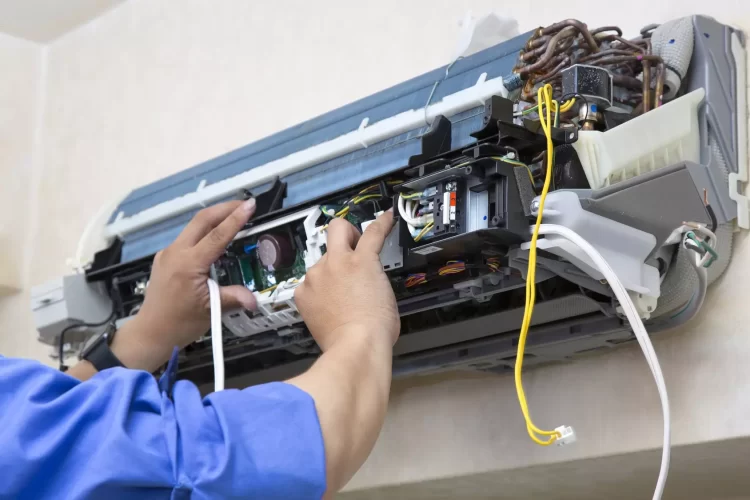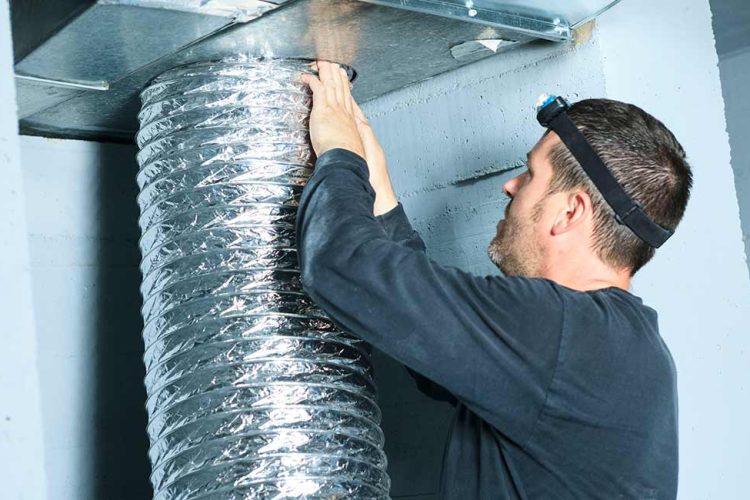
An HVAC system is essential for maintaining comfort in your home by regulating temperature and air quality. HVAC stands for Heating, Ventilation, and Air Conditioning, and it consists of several key components that work together to create a pleasant living environment. By familiarizing yourself with these essential parts, you can better care for your system, spot potential problems, and enhance overall efficiency. In this article, we’ll delve into the main components of HVAC systems and how each one contributes to its effectiveness.
1. Thermostat: The Brain of Your HVAC System
The thermostat serves as the control center for your HVAC system. It enables you to set your desired temperature and communicates with the system to keep it at that level. Thermostats can range from simple manual versions to sophisticated programmable models that allow for temperature scheduling. Today’s smart thermostats can even connect to your home’s Wi-Fi, giving you the ability to manage your HVAC system from your smartphone, no matter where you are.
Why It’s Important: A well-functioning thermostat is crucial for the efficient operation of your HVAC system, ensuring your home stays at a comfortable temperature. If the thermostat malfunctions, your system may either overheat or struggle to cool effectively, leading to energy waste and discomfort.
2. Compressor: Circulating Refrigerant
The compressor is a key component of air conditioning and heat pump systems. Found in the outdoor unit, its role is to compress the refrigerant gas and circulate it through the system, where it can be either cooled or heated. The compressor is responsible for moving the refrigerant through the evaporator and condenser coils, facilitating heat transfer—removing heat from your home when in cooling mode or adding heat when in heating mode.
Why It’s Important: A malfunctioning compressor can lead to ineffective cooling or heating. Issues with the compressor often necessitate professional help and can be expensive to replace, making regular maintenance of this component crucial.
3. Evaporator Coil: Absorbing Heat from Your Home
The evaporator coil is situated inside the air handler of your HVAC system. This part absorbs heat from the air in your home as refrigerant flows through it. The refrigerant evaporates in the coil, transforming into a gas as it takes in heat, which is then transported outside by the compressor.
Why It’s Important: A dirty or frozen evaporator coil can hinder your HVAC system’s efficiency, forcing it to work harder than needed. Regular cleaning and maintenance of the evaporator coil are vital for optimal performance and to avoid expensive repairs.
4. Condenser Coil: Releasing Heat Outside
The condenser coil is found in the outdoor unit of your HVAC system, usually next to the compressor. After the refrigerant is compressed, it travels through the condenser coil, where it releases heat from inside the home. As the refrigerant cools, it condenses back into a liquid and returns to the evaporator coil for another cycle.
Why It’s Important: If the condenser coil is dirty or obstructed by debris, it can lead to overheating and diminish the system’s ability to cool your home effectively. Regular cleaning of the condenser coil is essential for smooth operation and maintaining energy efficiency.
5. Blower Fan: Circulating Air
The blower fan is tasked with circulating air throughout your home. After the air has been heated or cooled by the HVAC system, the blower fan pushes it through the ductwork and into the various rooms. It plays a crucial role in maintaining airflow and ensuring that conditioned air reaches every area of your home.
Why It’s Important: A malfunctioning blower fan can result in inadequate airflow, leading to inconsistent heating or cooling in your home. If you experience weak airflow or hear unusual noises from your vents, it may indicate an issue with the blower fan.
6. Ductwork: Delivering Air Throughout Your Home
Ductwork consists of metal or flexible pipes that transport heated or cooled air from the HVAC system to various rooms in your home. This system includes supply ducts, which bring air into the rooms, and return ducts, which carry air back to the system for reconditioning.
Why It’s Important: Leaky or poorly insulated ducts can cause significant energy loss, forcing your HVAC system to work harder and driving up your energy bills. Regular inspections and sealing of the ducts can enhance your system’s efficiency and improve indoor comfort.
7. Air Filter: Protecting the System and Improving Air Quality
The air filter is an essential part of the HVAC system that helps maintain clean air while safeguarding the system’s internal components. It captures dust, dirt, and other debris before they enter the system, preventing damage to sensitive parts like the coils and blower fan.
Why It’s Important: A clogged air filter can hinder airflow, leading to system overheating and decreased efficiency. It can also compromise indoor air quality by allowing allergens and dust to circulate throughout your home. Regularly replacing the air filter is one of the simplest ways to keep your HVAC system in good shape.
8. Expansion Valve: Regulating Refrigerant Flow
The expansion valve is a small yet vital component in HVAC systems, especially in air conditioners and heat pumps. It controls the flow of refrigerant into the evaporator coil, ensuring that the refrigerant enters at the right pressure and temperature. This regulation is key to maintaining efficient heat absorption and overall system performance.
Why It’s Important: If the expansion valve malfunctions, it can disrupt the refrigerant flow, resulting in poor system performance, ineffective cooling or heating, and potential damage to the compressor.
9. Heat Exchanger: Essential for Heating
The heat exchanger is the part of the HVAC system responsible for transferring heat to or from the air in your home. During heating mode, it extracts heat from the combustion process (in gas furnaces) or the heat pump and delivers it into the air to warm your living space.
Why It’s Important: A damaged or cracked heat exchanger poses a safety risk, as it can allow harmful gases, like carbon monoxide, to seep into your home. Regular maintenance and inspection of this component are essential for both safety and efficiency.
10. Humidifier/Dehumidifier: Controlling Humidity
In addition to heating and cooling, some HVAC systems come equipped with a humidifier or dehumidifier to manage the humidity levels in your home. A humidifier introduces moisture into the air during the dry winter months, while a dehumidifier extracts excess moisture during the humid summer months. These devices are essential for maintaining a comfortable and healthy indoor atmosphere.
Why It’s Important: Proper humidity control helps prevent problems like dry skin, allergies, and mold growth. It also contributes to the comfort and efficiency of your HVAC system.
11. Reversing Valve: Switching Between Heating and Cooling
The reversing valve plays a crucial role in heat pump systems. It enables the system to alternate between heating and cooling modes by changing the direction of the refrigerant flow. In cooling mode, the refrigerant takes in heat from inside the house and releases it outside. Conversely, in heating mode, it absorbs heat from the outside air and transfers it indoors.
Why It’s Important: If the reversing valve malfunctions, the heat pump may fail to switch between heating and cooling modes, making it ineffective at maintaining your desired indoor temperature. Regular inspections of the reversing valve are essential, particularly in areas with fluctuating temperatures.
12. Condensate Drain: Removing Excess Moisture
The condensate drain is tasked with eliminating excess moisture that accumulates during the cooling process. As the evaporator coil cools the air in your home, water vapor condenses into liquid and must be drained away. This moisture is usually directed through a drain line to an outside location.
Why It’s Important: A blocked condensate drain can lead to water backing up into your HVAC system, which may result in water damage, mold growth, or even system failure. Regularly checking and cleaning the drain line is vital to ensure proper moisture removal and to avoid costly repairs.
13. Control Board: The Heart of the HVAC System
The control board, often referred to as the circuit board, serves as the brain of the HVAC system. It manages the operation of all components, ensuring they work together seamlessly. The control board interacts with the thermostat, blower fan, compressor, and other elements, coordinating their functions to maintain a comfortable environment.
Why It’s Important: A malfunctioning control board can lead to erratic system behavior, such as unexpected on and off cycles, failure to heat or cool, or even complete system shutdowns. Diagnosing a faulty control board can be challenging without professional assistance, but its proper functioning is essential for the overall performance of the HVAC system.
Conclusion
Gaining an understanding of the various parts of an HVAC system and their interconnections can empower homeowners to troubleshoot issues and maintain their systems more effectively. Key components like the compressor, thermostat, and evaporator coil are vital for optimal performance. Regular maintenance, cleaning, and professional inspections of these parts can enhance system efficiency, reduce energy costs, and prolong the lifespan of your HVAC system, ensuring your home remains comfortable year-round.




